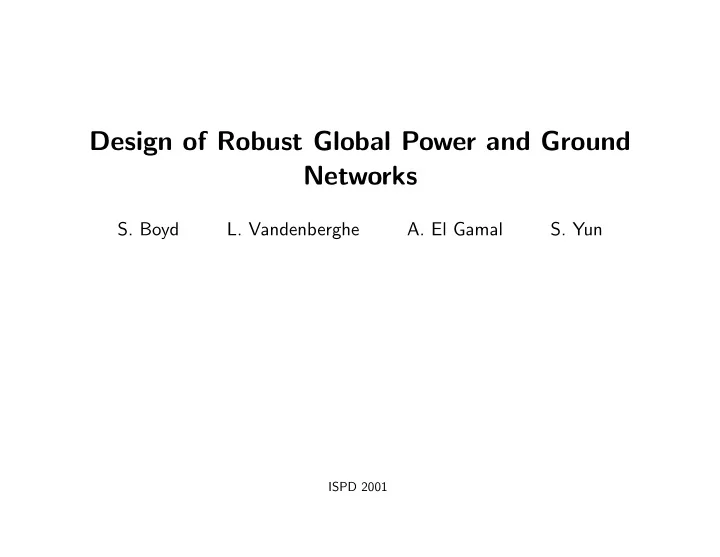

Design of Robust Global Power and Ground Networks S. Boyd L. Vandenberghe A. El Gamal S. Yun ISPD 2001
Global power & ground network design Problem: size wires (choose topology) • minimize wire area subject to node voltage, current density constraints • don’t consider fast dynamics (C,L) • do consider (slow) variation in block currents ISPD 2001 1
(Quasi-)static model g k V j I j • segment conductance g k = w k / ( ρl k ) ; current density j k = i k /w k k w k a k a T k ; node voltages V = G ( w ) − 1 I • conductance matrix G ( w ) = � • statistical model for block currents: E II T = Γ – Γ is block current correlation matrix – Γ 1 / 2 = RMS ( I j ) ; Γ ij gives correlation between I i , I j jj ISPD 2001 2
Sizing problem minimize A = � k l k w k (area) subject to V j ≤ V max (node voltage limit) E j 2 k ≤ j 2 (RMS current density limit) max w k ≥ 0 (nonneg. wire widths) can’t solve, except special case I constant • (Erhard & Johannes) can improve any mesh design by pruning to a tree • (Chowdhury & Breuer) can size P&G trees via geometric programming ISPD 2001 3
Meshes, trees and current variation w 2 I 1 I 2 w 1 w 3 • I 1 , I 2 constant (or highly correlated): set w 2 = 0 (yields tree) • I 1 , I 2 anti-correlated: better to use w 2 > 0 (yields mesh) ISPD 2001 4
Average power formulation • power dissipated in wires: P = V T I = I T G ( w ) − 1 I • average power: E P = E I T G ( w ) − 1 I = Tr G ( w ) − 1 Γ Tr G ( w ) − 1 Γ + µ � minimize k l k w k (average power + µ · area) subject to w k ≥ 0 • parameter µ > 0 trades off average power, area • nonlinear but convex problem , readily (globally) solved • indirectly limits E j 2 k , V j ISPD 2001 5
Properties of solution observation: many w k ’s are zero, i.e. , many wires aren’t used average power formulation can be used for P&G topology selection: • start with lots of (potential) wires • let average power formulation choose among them • topology (given by nonzero w k ) independent of µ resulting current density and node voltages: • RMS current density is equal in all (nonzero) segments in fact µ = ρj 2 max yields E j 2 k = j 2 max in all (nonzero) segments • observation: V j are small ISPD 2001 6
Example 10 9 8 s1 7 s2 6 s4 5 s3 s5 4 3 s7 2 s6 1 s8 0 −1 −1 0 1 2 3 4 5 6 7 8 9 10 • 10 × 10 grid, each node connected to neighbors (180 segments) • 8 current sources, I ∈ R 8 is random with three possible values • 4 ground pins on the perimeter (at corner points) ISPD 2001 7
design for constant currents (with same RMS values) 10 • a tree; each source connected 9 8 s1 to nearest ground pin 7 s2 6 s4 5 s3 • RMS current density 1, 4 s5 3 s7 area = 448, 2 s6 1 s8 max. voltage = 7.7 0 −1 −1 0 1 2 3 4 5 6 7 8 9 10 design via average power formulation 10 9 • mesh, not a tree 8 s1 7 s2 6 s4 5 s3 • RMS current density 1, 4 s5 3 s7 area = 347, s6 2 max. voltage = 5.7 1 s8 0 −1 −1 0 1 2 3 4 5 6 7 8 9 10 ISPD 2001 8
Barrier method use Newton’s method to minimize Tr G ( w ) − 1 Γ + µl T w − β ( i ) � log w k k • barrier term − β � k log w k ensures w k > 0 • solve for decreasing sequence of β ( i ) • can show w ( i ) is at most nβ ( i ) suboptimal • O ( n 3 ) cost per Newton step works very well for n < 1000 or so; easy to add other convex constraints ISPD 2001 9
Pruning • often clear in few iterations which w k are converging to 0 • removing these w k early greatly speeds up convergence • sizes 1000s of w k s in minutes ISPD 2001 10
Where Γ comes from � T sim 1 I ( t ) I ( t ) T dt • from simulation: Γ = T sim 0 • or, from block RMS currents and estimates of correlation: Γ ij = RMS ( I i ) RMS ( I j ) ρ ij • can use eigenvalue decomposition to simplify Γ r ˆ � λ i q i q T � λ i q i q T Γ = i , Γ = i i i =1 (reduced rank approximation speeds up avg. pwr. solution) ISPD 2001 11
Conclusion • P&G meshes outperform trees when current variation taken into account • Average power formulation – yields tractable convex optimization problem – chooses topology – guarantees RMS current density limit – indirectly limits node voltages ISPD 2001 12
Recommend
More recommend